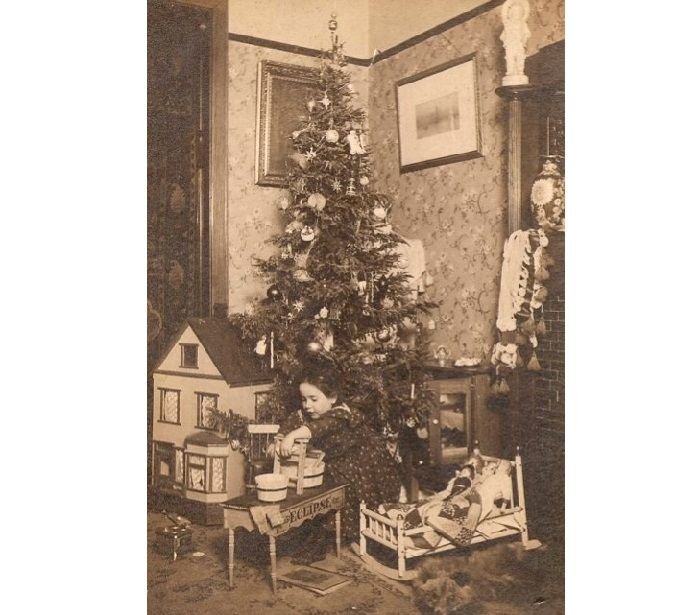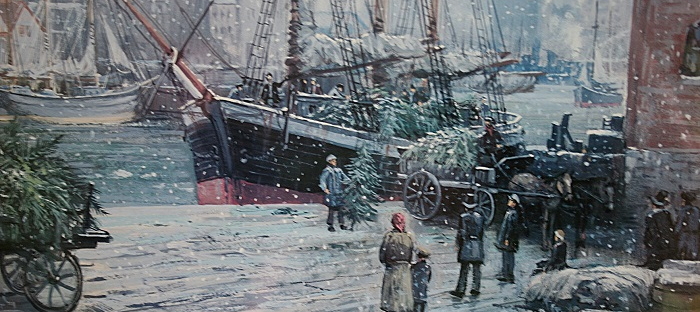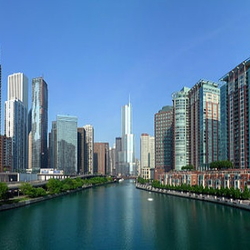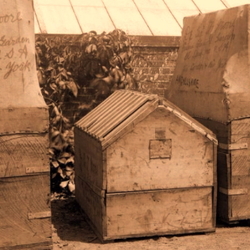Beginning in late November, ships sailed into Chicago's harbor, delivering cargoes of thousands of Christmas trees from the upper peninsula of Michigan. Improved road and rail transport brought an end to this practice. But tales of Chicago's Christmas tree ship tradition and of one popular sea captain in particular have become part of Chicago Christmas legend.
The latter half of the 1800s saw increasing demand for Christmas trees in Chicago, due largely in part to an influx of German immigrants who brought with them Old World Christmas traditions and treasured tree ornaments. Rural Wisconsin and Michigan offered merchants a ready supply of holiday evergreens. At that time, however, land transportation from the north was poor, and shipment of trees by road or rail could be held up by inclement weather. In comparison, those who took advantage of relatively quick water shipping were immediately successful. Destined to become the most famous Chicago Christmas tree merchant of all was maritime Captain Herman Schuenemann, who supplied so many city residents with trees that he became known as “Captain Santa,” and his schooner, the Rouse Simmons, as the “Christmas Tree Ship.”
The arrival of the Christmas tree ship in the Chicago harbor became a highly-anticipated tradition for thousands of Chicagoans, beginning when Captain Schuenemann navigated his schooner into the Chicago River and docked at Clark Street. Whole families would meet the ship, where they could choose and purchase a tree right on deck. A six- or seven-foot tree cost 75 cents. The highest trees, some as tall as 20 feet, were destined for donation to churches or orphanages.
Herman Schuenemann was no stranger to the hazards of travel on Lake Michigan. His oldest brother, August, who had been among the first to transport Christmas trees from the north, had been shipping trees to Chicago when all on board his craft perished in a November 1898 storm. Only two years later, Herman himself lost a vessel named the Mary Collins, but fortunately this shipwreck occurred close to the Michigan shore so that no lives were lost.
By 1912, Schuenemann had been serving as Chicago's "Captain Santa" for over 25 years. The era of the Christmas tree ship was destined to end, however. On the afternoon of November 22, 1912, Schuenemann and his crew departed from the dock at Thompson, Michigan, en route for Chicago. The schooner was so heavily laden with 3,000 to 5,000 evergreen trees that some eyewitnesses described it as a “floating forest.” Sometime during the night, a furious winter gale struck the lake. When a U.S. Coast Guard station keeper in Two Rivers, Wisconsin, spotted the schooner with its flag at half-mast, indicating distress, he dispatched the station’s powerboat. Though rescuers searched for several hours, the schooner appeared to have vanished into the darkness and snow. At first, family members hoped that Schuenemann was merely delayed because he had docked for safety from the storm, but after weeks passed with no word from those on board, the men were given up for dead. For months after the gale, cut trees washed up on the shores of Wisconsin beaches. In 1924, fishermen hauling in their nets recovered Schuenemann’s wallet, its contents preserved by an oilskin wrapper.

This charming photograph, taken in Chicago in 1906, is of my husband’s grandmother, Elizabeth Lange Martin. There is every reason to believe that the German immigrant Lange family, like so many other Chicagoans, purchased their Christmas tree from Captain Schuenemann.
In 1971, scuba diver Kent Bellrichard was searching for another shipwreck when he discovered the ruins of Schuenemann’s ill-fated vessel 165 feet below the surface of Lake Michigan, just north of Two Rivers. Exploratory dives revealed the name Rouse Simmons on the ship’s quarterboards, as well as a hold crowded with the remains of hundreds of evergreens which never arrived at their final destination in Chicago’s harbor. Divers investigating the wreck theorized that the ship’s crew were headed toward shore and preparing to drop anchor just before they were taken down by the storm.
The precise cause of the wreck of the Rouse Simmons remains unknown, but that has only increased the power of its legend through the years. Chicago’s first municipal Christmas tree was erected in 1913, one year following the schooner’s disappearance. The electric light-studded 35-foot evergreen, which the Chicago Tribune declared belonged to “the newsboy, the bootblack, the poor of the city,” was dedicated to the memory of Captain Herman Schuenemann. Today the crew of the U.S. Coast Guard Cutter Mackinaw continues the tradition, traveling from northern Michigan to Chicago to distribute holiday trees to needy families.
Sources:
The Historic Christmas Tree Ship by Rochelle Pennington, Pathways Press, 2004
National Archives: The Christmas Tree Ship - Captain Herman E. Schuenemann and the Schooner Rouse Simmons
Wisconsin Historical Society: New Findings on the Fate of the Christmas Tree Ship
Image Credits:
Permission to use The Christmas Tree Schooner by artist Charles Vickery graciously granted by The Clipper Ship Gallery in LaGrange, Illinois


















